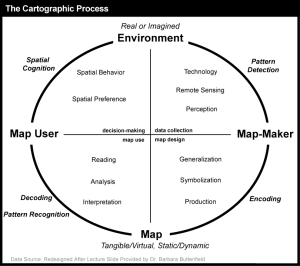There is a famous saying that a picture is worth a thousand words, but whoever said this wasn’t very familiar with cartography.
Cartography is the art of reading maps and the science involved in navigating routes and ways. If you invest sufficient time and energy towards learning this skill, you will realize that every map has a tale to tell and is definitely a lot more than curvy lines leading you from one destination to the other.
What is Abstraction?
Abstraction is a systematic process that is closely twined with the principle of cartography. In essence, abstraction helps to transform a real life location into the tiny dot represented on a map. This process involves the articulate mathematical concept of scale representation. Cartographers exercise great care in constructing maps, since it is next to impossible to calculate every single detail in the process of abstraction. Thus, map makers build an abstraction of reality, one that has greater use and utility than the actual location itself.
For instance, you have been assigned to plot down the map of the Lone Star state of Texas. If you try to calculate every single element in your map, you would naturally require a map the actual size of the state. This principle falters on grounds of practicality and utility.
Thus, this is where the process of abstraction is used to single out the most vital elements of a place. Whenever you are trying to draft a map, consider yourself a writer. Ask yourself, what would you want to tell your audience? How would you want to direct them and guide them from one place to another? As much as attention to detail is crucial in the process of abstraction, it is extremely important to filter out the relevant from the irrelevant.
How do you generalize?
When you abstract reality and try to condense it in the form of a map, you cannot be absolutely sure of its accuracy. Therefore, it is extremely important for map makers to carefully decide what to include and exclude on their map. To make this process easier, cartographers generalize.
For example, excluding major locations such as post offices and airports is out of the question. You can, however, exclude things like fountains and monuments that simply help beautify the reality. Make sure you don’t include too many details on the map; otherwise you will end up crowding it up- making it too confusing for your readers. An author, in an attempt to help his readers visualize, might end up describing every minute detail. However, in trying to say a lot, the main essence of the story is lost in meaningless words. Same is the case with cartography; you need to assess what is critical versus what isn’t.
Similarities between Journalism & Cartography
Just like journalism, a certain percentage of bias exists in terms of drafting maps. The same story might appear to be completely different, based on the angle taken by each journalist. Likewise, each map maker adds a unique tangent to their story- based on their varied perspectives and sense of judgments. Transforming a round planet on a rectangular piece of paper is not an easy work! Shapes, sizes and appearances are, more often than not distorted. What may appear to be a huge chunk of Greenland might actually turn out to be a fragment of it on a piece of paper.
Conclusion:
Designing a map is so much more than just abstractions and projections. A lot depends on the cartographer- their experience, judgments and dedication to tell the story right! Just like a novelist is faced with the task to put down years of observations and experiences in a limited set of words, cartographers are faced with the dilemma of putting down the actual story in a limited set of lines and routes. Articulation is the key to designing a good map and attention to detail is of the essence.
It is safe to say that cartography and journalism have quite a few similarities, in the way both are practiced as a discipline. The success of both is subject to the efficacy and skills of their writer. However, the former requires finesse and clarity in terms of representation- without which the map would fail to fulfill the purpose as a guiding mechanism.
Be sure and let us know in the comments below if this article was helpful, or you have any questions.
References:
http://blogs.scientificamerican.com/guest-blog/2012/05/07/what-cartography-taught-me-about-science-writing/



